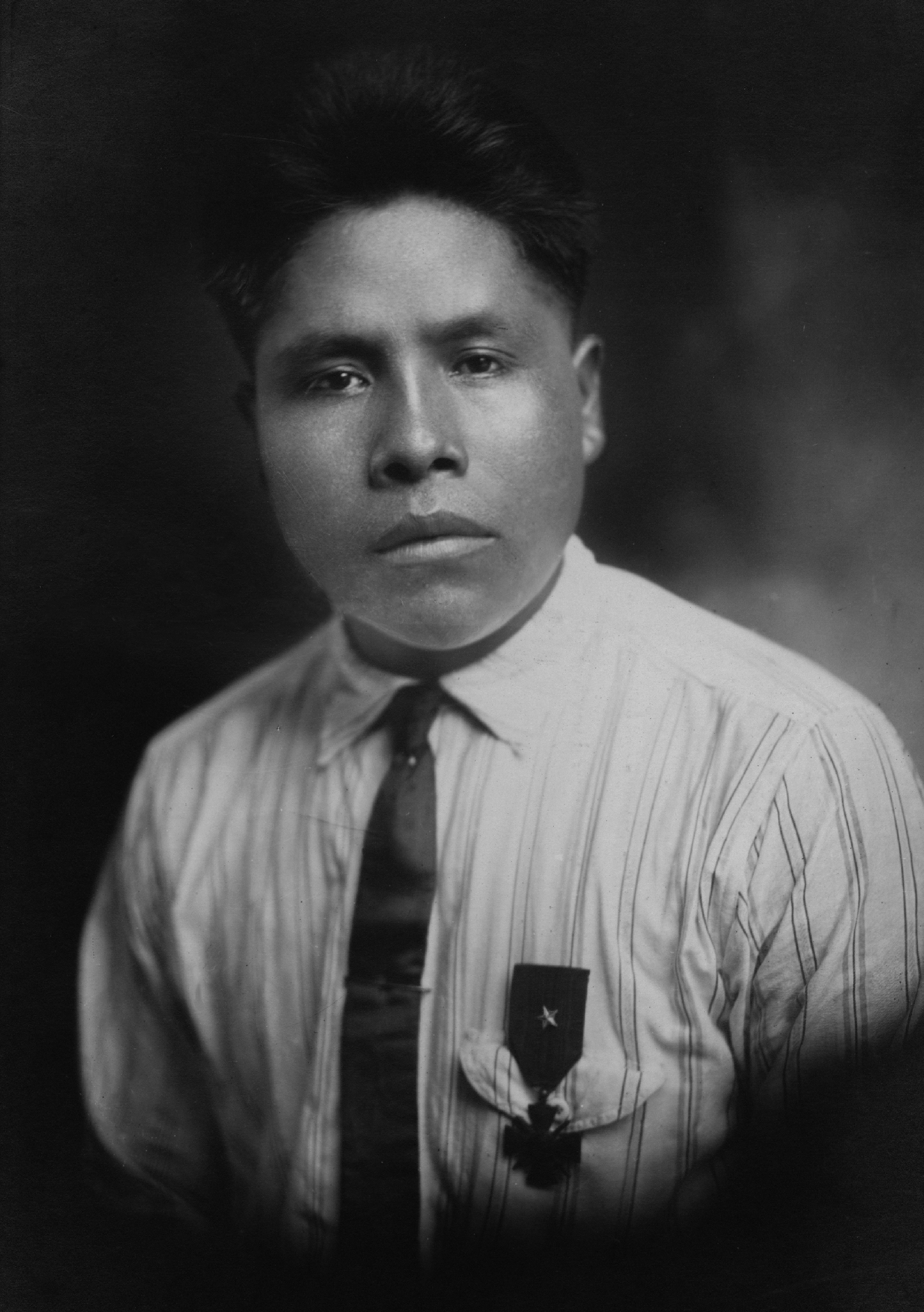
CODE TALKERS.
Oklahoma Indians have the distinction of being the first American Indian code talkers in both World Wars. Two forms of American Indian Code Talking exist: Type One or intentionally encoded native languages, and Type Two or noncoded native languages. While the former served as a foreign and coded language form usually with organized training, the latter served only as a foreign language and in impromptu situations. Among Oklahoma Indians only the Choctaw in World War I and the Comanche in World War II are known to have served as Type One code talkers.
The first code talkers were a group of Choctaws in the 141st, 142d, and 143d Infantry Regiments of the Thirty-sixth Infantry Division in World War I. During the Meuse-Argonne campaign of 1918 in France, Germans broke Allied communication codes, monitored radio and telephone lines, and captured one of every four runners between companies. Needing a more secure means of communication, an American army officer overheard some Choctaw soldiers conversing in their native language.
After an initial test and brief training in telephone messages, a Choctaw was placed in each post command. Coded words were soon devised for military terms foreign to the Choctaw language. For instance, "little gun shoot fast" meant machine gun. Choctaw messages transmitted by field telephone and in writing led to major successes in the battles of St. Etienne and Forest Ferme, contributing to the war's end.
The original Choctaw Code Talkers included Solomon Louis, Mitchell Bobb, Ben Carterby, Robert Taylor, Jeff Nelson, Pete Maytubby, James Edwards, and Calvin Wilson. They were joined later by Albert Billy, Victor Brown, Tobias Frazier, Benjamin Hampton, Joseph Oklahombi, Walter Veach, Benjamin Colbert, George Davenport, Joseph Davenport, Noel Johnson, and Otis Leader. Toward the end of the war Oklahoma Cherokees, Comanches, Cheyennes, and Osages also served as code talkers.
In December 1940 the army recruited the following seventeen Comanches to become code talkers: Charles Chibitty, Haddon Codynah, Robert Holder, Forrest Kassanavoid, Wellington Mihecoby, Perry Noyabad, Clifford Otitivo, Simmons Parker, Melvin Permansu, Elgin Red Elk, Roderick Red Elk, Albert Nahquaddy Jr., Larry Saupitty, Morris Tabbyetchy (Sunrise), Anthony Tabbytite, Ralph Wahnee, and Willie Yacheschi. Assigned to the Fourth Infantry Division's Fourth Signal Company at Fort Benning, Georgia, they received phone, radio, Morse code, and semaphore training.
In August 1941 they were placed under Lt. Hugh F. Foster to develop an unbreakable Comanche-language code. Foster provided approximately 250 specialized military terms for which the Comanches developed coded equivalents. Combined with standard Comanche, coded terms such as tutsahkuna' tawo'i' (sewing-machine gun [machine guns]), wakaree'e (turtle [tanks]) and Po'sa taiboo' (Crazy White Man [Hitler]) were developed. By October 30, 1941, the Comanche had completed their training and conducted field exercises in Louisiana soon thereafter.
Thirteen Comanche Code Talkers landed at Utah Beach during the Normandy invasion in France. Maintaining wire telephone lines and sending secure messages via field telephone and radio, they served in France, Luxembourg, Belgium, and Germany. Their service included important battles at Cherbourg, St. Lo, Paris, the Siegfried Line, the Huertgen Forest, and Bastogne. Although several were wounded in action, none were killed. The Comanche code was never broken.
Other World War II Oklahoma Indians who used their languages on radios as Type Two code talkers include: Schlicht Billy, Andrew Perry, Davis Pickens, and Forrester Baker (Choctaw) of K Company, 180th Infantry Regiment, Forty-fifth Infantry Division; John Tsatoke, James Paddlety, and Leonard Cozad (Kiowa) of the 689th Field Artillery Battalion, Twentieth Corps; Edmund Harjo (Seminole) and Leslie Richards (Muscogee Creek) in the Aleutian campaign; and Henry Stoneroads and Enoch Jim (Pawnee) in the Philippines.
During World War II most American Indians enlisted for a complex combination of traditional cultural (warrior-based themes), acculturative (boarding school), and economic (unemployment) reasons, and out of tribal and national patriotism. Their desire to serve as a unit and their ability to provide a unique form of military communications provided additional motivations for the Indian Code Talkers.
Over the years the Oklahoma Indian Code Talkers have been honored at tribal, state, and national celebrations. Efforts to identify and gain federal recognition for all American Indian Code Talkers led to the Code Talkers Recognition Act, signed into law in November 2008 by Pres. George W. Bush. The legislation honored the service of each individual code talker and the participation of each tribe. On November 3, 1989, the French government and the State of Oklahoma bestowed the Chevalier de L'Order National du Merite (Knight of the Order of National Merit), posthumously to the World War I Choctaw and to the three then-surviving World War II Comanche Code Talkers (Chibitty, Kassanavoid, and Roderick Red Elk) at the Oklahoma Capitol. Efforts to identify and gain federal recognition for all American Indian Code Talkers led to the proposal of the Code Talkers Recognition Act (H.R. 4597/S.1035) in the 109th Congress. The Oklahoma Indian Code Talkers have contributed to a growing national awareness of American Indian Code Talkers and the importance of maintaining Indigenous languages.







